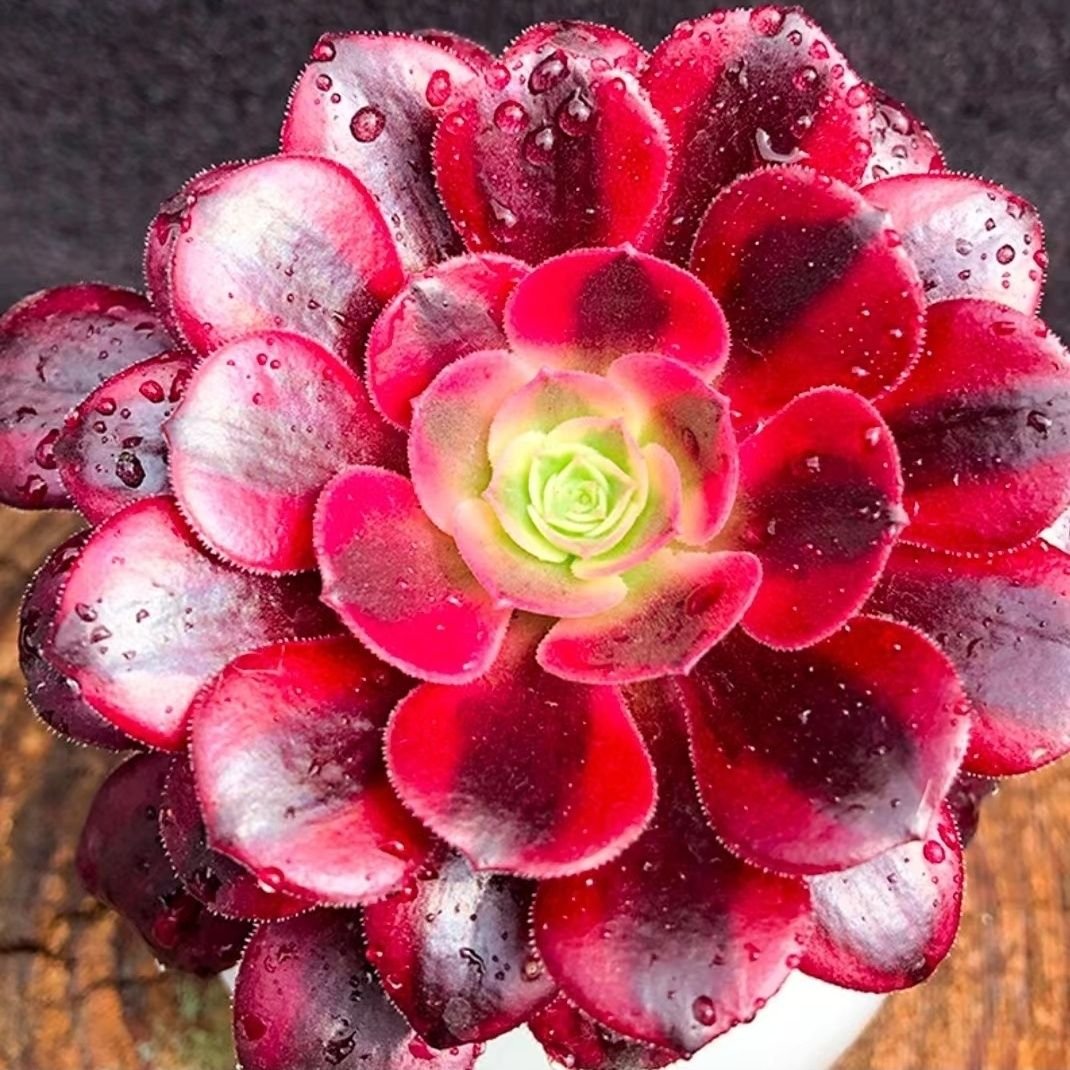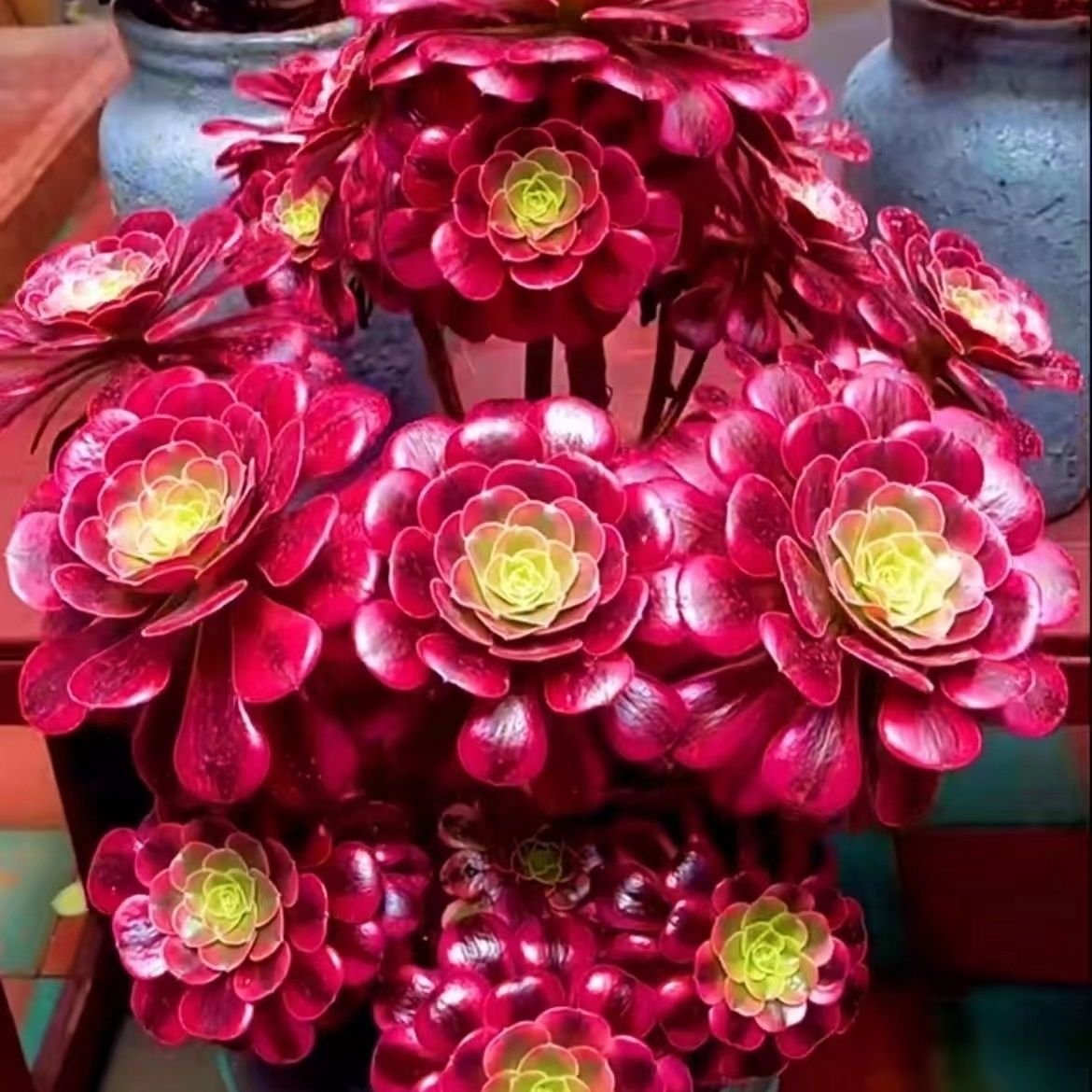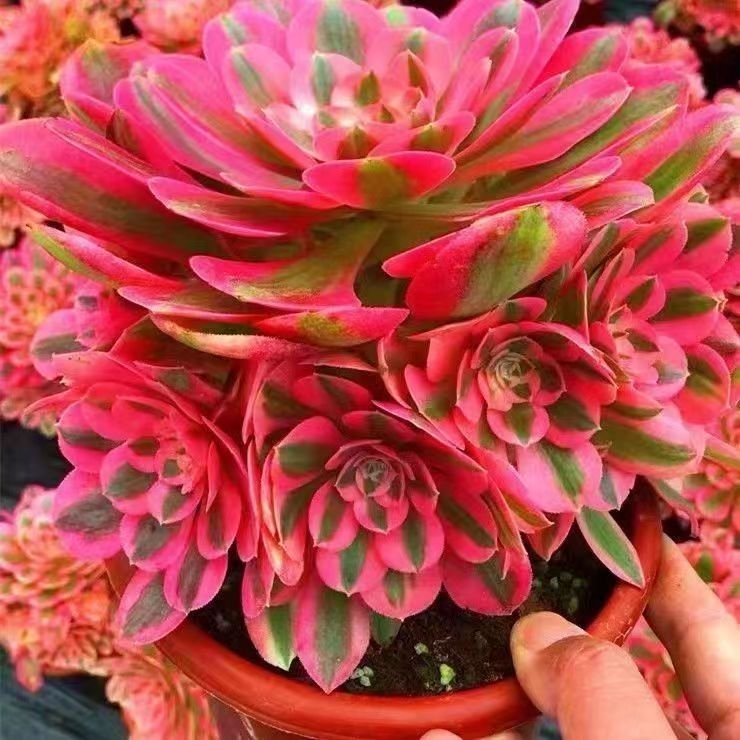
If you want to know how to care for aeonium medusa, start with the basics: give it bright light, water only when the soil dries out, use well-draining soil, and keep it in a spot with mild temperatures. Aeonium medusa stands out among succulents with its bold, wavy leaves and unique rosette shape. You will find that growing this succulent at home is simple and rewarding. Wondering how to grow aeonium or keep it happy? Let’s dive in!
Key Takeaways
- Put Aeonium Medusa in bright, indirect light. Give it some shade in the afternoon. This helps its leaves stay healthy and bright.
- Water the plant deeply, but only when the soil is dry. Change how often you water as the seasons change. This stops you from watering too much.
- Use soil that drains well. Mix in sand and perlite. Pick pots with holes at the bottom. This keeps the roots from rotting.
- Keep the plant in mild temperatures from 60° to 75°F. Protect it from frost and very hot weather.
- You can make new plants from stem cuttings in spring. Cut off dead leaves often. Check for bugs to help your plant grow well.
Light for Aeonium Medusa

Sunlight Needs
You want your aeonium medusa to look its best, so give it the right amount of light. This plant loves full sun to partial shade. Outdoors, place it where it gets morning sunlight and some afternoon shade. Too much harsh afternoon sun can burn the leaves. Indoors, bright indirect light works well. A spot near a sunny window is perfect. If you live in a hot climate, protect your aeonium medusa from the strongest midday rays.
Tip: In spring and fall, move your plant to a sunny and well-ventilated area. This helps it grow strong and healthy. During summer, choose a cooler spot with filtered light. Aeonium medusa does not like extreme heat.
Indoor Placement
When you grow aeonium medusa inside, think about where the light comes in. South or east-facing windows usually give enough light. If your room feels dark, try using a grow light. Place the plant about a foot away from the window. This keeps the leaves from getting scorched. Rotate your pot every week. This helps all sides of the plant get even light and keeps the rosette shape nice and full.
- Best indoor spots for aeonium medusa:
- Near a bright window with sheer curtains
- On a sunny windowsill that does not get too hot
- Under a grow light for at least 6 hours a day
Aeonium medusa, like many succulents, has strong drought resistance. It can handle less water if it gets enough light.
Signs of Light Stress
You can tell if your aeonium medusa is getting too much or too little light by watching its leaves. If the leaves look faded, crispy, or have brown spots, the plant might get too much sun. If the rosette stretches out and the leaves look pale or droopy, it needs more light.
| Symptom | Cause | Solution |
|---|---|---|
| Brown, crispy edges | Too much direct sun | Move to filtered light |
| Pale, stretched leaves | Not enough light | Move closer to a bright window |
| Leaf drop | Sudden light change | Adjust placement gradually |
Watch your plant every week. If you see changes, adjust the light right away. Aeonium medusa will reward you with bold, healthy leaves when you get the light just right.
Watering Aeonium Medusa
Soak and Dry Method
When you think about how to water aeonium, the soak and dry method works best. This means you give your plant a deep drink, then wait until the soil dries out before watering again. For aeonium medusa, you can soak the soil once every two to three weeks. Let the water run through the pot until it drains out the bottom. After that, let the soil dry completely before you water again.
Some gardeners like to soak the whole pot for about 15 to 30 minutes, just like you would with other succulents such as Tillandsia Caput Medusae. This helps the roots get enough moisture without sitting in water. If you follow this method, you help your aeonium medusa avoid root rot and keep the leaves from curling or turning brown.
Tip: Always check the soil with your finger. If the top two inches feel dry, it is time to water. If it still feels damp, wait a few more days.
Seasonal Watering
Aeonium medusa changes its needs with the seasons. In spring and fall, your plant grows the most. You should water every two to three weeks, using the soak and dry method. During summer, aeonium medusa goes dormant. It stops growing and needs less water. Cut back on watering during this time. Sometimes, you may only need to water once a month in the hottest part of summer.
In winter, keep your plant in a cool spot and water less often. The soil should always dry out between waterings. Remember, aeonium medusa likes a bit more moisture than some other succulents, but it still hates soggy roots.
- Spring/Fall: Water every 2-3 weeks
- Summer (Dormant): Water once a month or less
- Winter: Water sparingly
Aeonium medusa has good water retention capabilities, so it can handle a missed watering now and then. If you ever wonder how to water aeonium during a certain season, just check the soil and watch your plant’s leaves.
Overwatering Signs
Overwatering is the most common mistake with succulents. Aeonium medusa will show you if it gets too much water. Look for these signs:
| Symptom | What It Means | What To Do |
|---|---|---|
| Mushy, soft leaves | Too much water | Let soil dry, reduce water |
| Yellowing leaves | Root rot starting | Remove damaged leaves |
| Foul smell from soil | Roots are rotting | Repot in fresh, dry soil |
If you see these problems, stop watering right away. Take the plant out of its pot and check the roots. Cut off any black or mushy roots. Repot your aeonium medusa in dry, well-draining soil.
Note: Underwatering is less harmful than overwatering for most succulents. If you forget to water, your plant will usually bounce back after a good soak.
With the right watering routine, your aeonium medusa will stay healthy and bright. Just remember to let the soil dry out, watch for signs of stress, and adjust your schedule with the seasons.
Soil and Potting

Best Soil Mix
Getting the right soil mix is key if you want your succulents to thrive. Aeonium medusa likes soil that drains fast but still holds some nutrients. You can use a cactus or succulent mix from the store, but you can also make your own. Try mixing equal parts of potting soil, coarse sand, and perlite. This blend keeps the roots happy by letting water flow through quickly.
You can add a small amount of compost or coconut coir. Compost gives your plant slow-release nutrients and helps the soil stay loose. Coconut coir holds moisture but does not make the soil soggy. Avoid using heavy soils like pure peat moss because they hold too much water and can cause root rot.
Tip: Aeonium medusa likes richer soil than most succulents, but it still needs excellent drainage.
Here’s a simple recipe for a great soil mix:
- 1 part potting soil
- 1 part coarse sand
- 1 part perlite
- A handful of compost or coconut coir
Pot Selection
Choosing the right pot helps your succulents grow strong. Pick a pot with drainage holes at the bottom. This lets extra water escape and keeps the roots from sitting in water. Clay or terracotta pots work well because they let the soil dry out faster. Plastic pots hold moisture longer, so you need to watch your watering.
When you repot aeonium medusa, use fresh, nutrient-rich soil. This gives your plant a boost and helps it settle in. After potting, place your plant in bright shade for a few days. This helps reduce transplant shock.
Drainage Tips
Good drainage keeps your succulents healthy. Always check that your pot has holes at the bottom. If you use a decorative pot without holes, place your plant in a plastic nursery pot first, then set it inside the decorative one.
| Pot Type | Drains Well | Holds Moisture | Best For |
|---|---|---|---|
| Terracotta | Yes | No | Most succulents |
| Plastic | Sometimes | Yes | Dry climates |
| Ceramic | Depends | Sometimes | Indoor use |
Never let water sit in the saucer under your pot. Empty it out after watering.
With the right soil and pot, your aeonium medusa will have a strong start and stay healthy for years.
How to Care for Aeonium – Temperature & Fertilizer
Temperature Range
Aeonium medusa likes mild temperatures. The best range for this plant is between 60° and 75°F (15.6 to 23.9℃). If you keep your plant in this range, it will grow strong and healthy. When the weather gets colder, move your plant inside. Frost can damage the leaves and roots. If you live in a place with cold winters, keep your aeonium medusa near a bright window, away from drafts. In summer, protect it from extreme heat by giving it some shade during the hottest part of the day.
Tip: If you ever wonder how to grow aeonium outdoors, remember to bring it inside before the first frost.
Humidity
You do not need to worry much about humidity with succulents. Aeonium medusa does well in average home humidity. Too much moisture in the air can cause problems like mold or rot. If your home feels very humid, make sure the air moves around your plant. Open a window or use a small fan. Dry air is not a problem for this plant. It can handle low humidity better than too much moisture.
| Humidity Level | Plant Response |
|---|---|
| Low to Average | Grows well |
| High (very humid) | Risk of rot or mold |
Fertilizing Tips
You want your aeonium medusa to look its best, so feed it during the growing season. Use a balanced, water-soluble fertilizer made for succulents. Apply it once a month in spring and fall. Do not fertilize in summer when the plant is dormant. Too much fertilizer can burn the roots. Always mix the fertilizer at half the strength listed on the package. Pour it onto damp soil, not dry soil, to avoid root damage.
A little fertilizer goes a long way. If you follow these steps, you will master how to care for aeonium and help your plant thrive.
Cultivate Aeonium Medusa – Propagation & Problems
Propagation Steps
If you want to grow more plants, learning how to propagate aeonium is simple. You can use stem cuttings. First, pick a healthy stem with a few leaves. Cut it off with clean scissors. Let the cutting dry for a day or two. This helps the cut heal and keeps it from rotting. Next, place the cutting in well-draining soil. Water it lightly after a few days. Roots will start to grow in about two weeks.
You can also try leaf cuttings, but stem cuttings work best. If you wonder how to propagate aeonium for the first time, just remember to keep things clean and dry. Soon, you will have new aeonium medusa plants to share or keep.
Tip: Spring is the best time to propagate. Your cuttings will root faster when the plant is growing.
Pruning and Repotting
Pruning helps your plant stay neat and healthy. Remove any dead or damaged leaves with your fingers or scissors. If you see a stem that looks weak, cut it back. This will help new growth appear. Repot your aeonium medusa every two years. Use fresh soil and a clean pot. This gives the roots more space and keeps the plant strong.
- When to prune: After flowering or if you see damaged parts.
- When to repot: When roots fill the pot or soil looks old.
Pest and Disease Issues
Even healthy succulents can get pests. Watch for mealybugs, aphids, or spider mites. You might see white fuzz or tiny bugs on the leaves. Wipe them off with a damp cloth or use insecticidal soap. If you notice black spots or mushy stems, your plant might have rot. Remove the damaged parts and let the soil dry out.
| Problem | What to Do |
|---|---|
| Mealybugs | Wipe leaves, use soap |
| Rot | Cut off bad stems, dry soil |
| Aphids | Spray with water or soap |
If you check your plant often, you can fix problems early. This makes it easy to cultivate aeonium medusa at home.
You can help aeonium medusa thrive at home with just a few simple steps. Keep the plant in bright light, water every 7 to 15 days, and use well-draining soil. Check out this quick guide:
| Care Aspect | Quick Tip |
|---|---|
| Watering | Every 7–15 days; less in dormancy |
| Fertilizer | Monthly, diluted, during growth |
| Soil | Loose, well-draining mix |
| Pot | Drainage holes; stones for tall pots |
| Temperature | 65–80°F; protect from frost |
Have you tried growing this unique succulent? Share your tips or questions in the comments below! 🌱
FAQ
How often should I repot my Aeonium Medusa?
You should repot your Aeonium Medusa every two years. Fresh soil helps the roots grow strong. If you see roots coming out of the pot, it is time to repot.
Can I grow Aeonium Medusa from a single leaf?
You might get lucky, but stem cuttings work much better. Leaf cuttings rarely root. For best results, use a healthy stem with a few leaves.
Why are my Aeonium Medusa’s leaves dropping?
Leaves can drop if your plant gets too little light, too much water, or sudden changes in temperature. Check the light and water first. Move your plant to a stable spot.
Tip: Old leaves at the bottom will drop naturally. That is normal!
Is Aeonium Medusa safe for pets?
Aeonium Medusa is not toxic to cats or dogs. You can grow it at home without worry. Still, try to keep pets from chewing on the leaves.